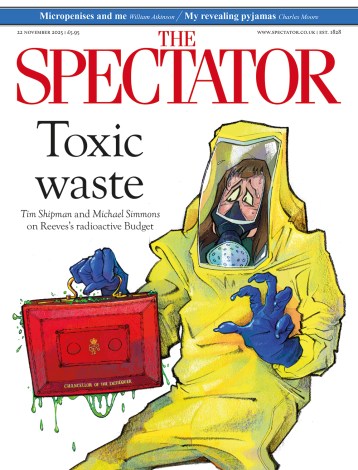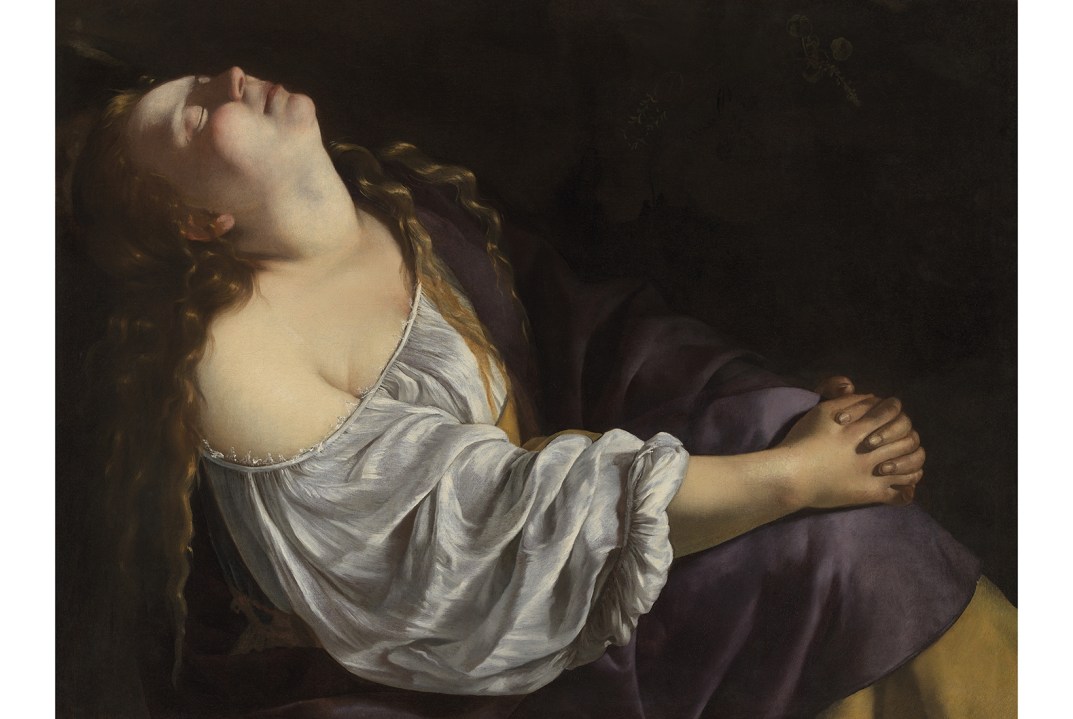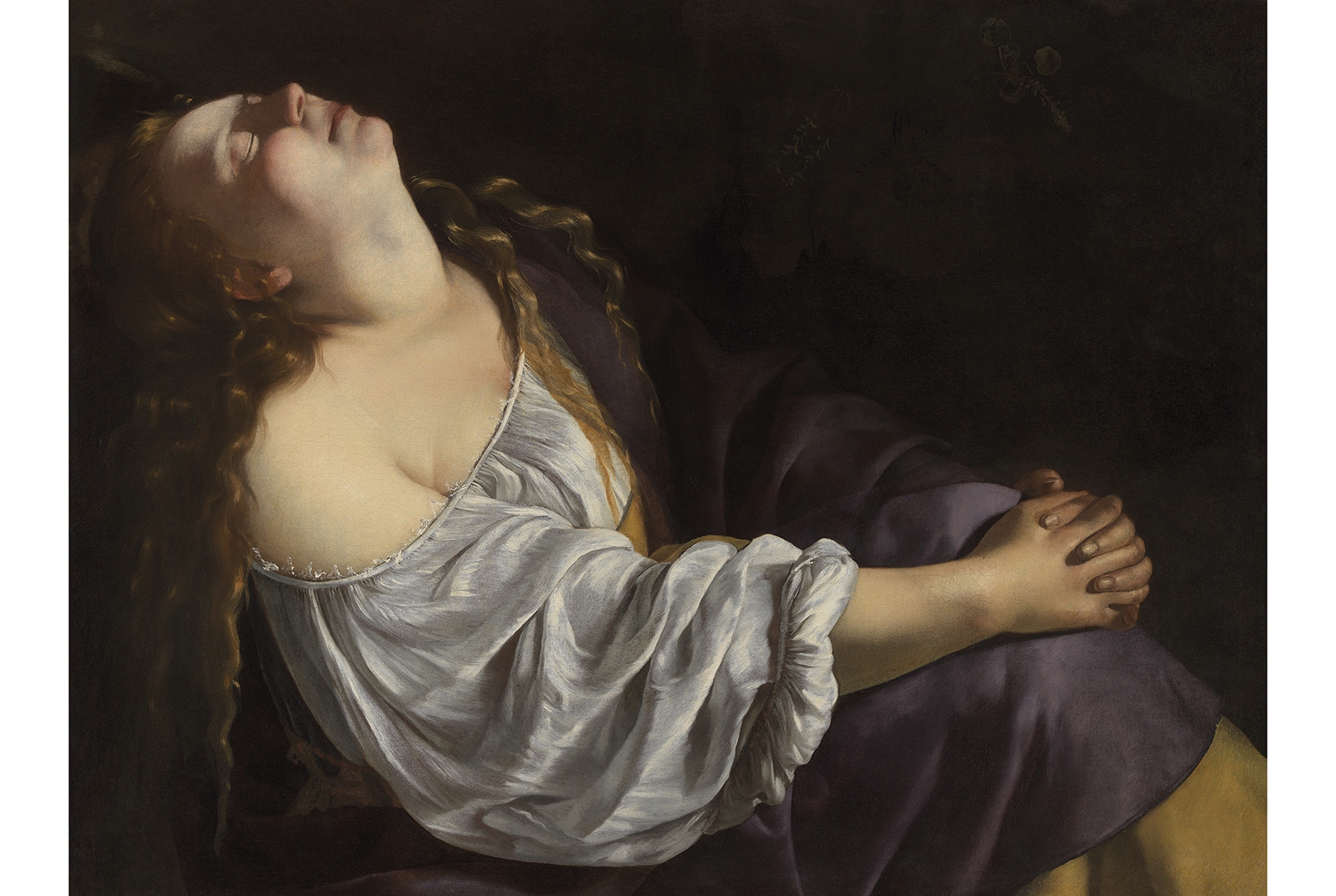‘It’s true, it’s true, it’s true.’ Over and over she said it. ‘E vero, e vero, e vero.’ It’s true he raped me. It’s true I was a virgin. It’s true all I say. Even under judicial torture, even with cords wrapped around her fingers and pulled tight, she did not waver. ‘E vero.’ These words, spoken by the 17-year-old Artemisia Gentileschi, have come down to us in a trial transcript of 1612. This haunting document, never seen outside the state archives in Rome, will be shown for the first time in the National Gallery’s forthcoming Artemisia exhibition.
Artemisia ought to have opened this month. Curator Letizia Treves has been through hell and high water. Italy in lockdown. American flights suspended. Lenders in quarantine. By mid-March, the logistics had become impossible. ‘Artemisia is postponed,’ says Treves by phone. ‘She is definitely not cancelled. We will do everything to make this exhibition happen.’ The catalogue is already printed. Order a copy as an anticipatory ankle-flash of the show to come.
Artemisia Gentileschi (1593–1652/3), who faced rape, humiliation, slander and successive outbreaks of the plague, overcame all. Her mother died when she was 12, leaving Artemisia to care for her father Orazio Gentileschi, a Pisan painter established in Rome, and three surviving younger brothers. Orazio, said his contemporaries, was a loner: savage, sarcastic, controlling, foolish with money, lecherous with women. In one way, at least, he was enlightened: he taught his daughter to paint. Between cooking, cleaning, mending and washing, Artemisia ground pigments, took up her brushes and mahlstick and copied, copied, copied from engravings and from her father’s works. She could not learn as a man learnt: could not go about Rome with chalks and paper, could not attend the Accademia, could not draw from the model. Her early nudes have a podgy formlessness, like ice creams beginning to slip in the sun. ‘Staying at home,’ she said, ‘was noxious for me.’
Artemisia faced rape, humiliation, slander and successive outbreaks of the plague but overcame all
All the more insulting then, when in 1612 at the rape trial brought against Agostino Tassi, a supposed friend and collaborator of her father’s, Artemisia was painted by the defence as a heartbreaker, putting it about Rome, standing at windows, posing naked for her father. Tassi, her rapist, was already married, had been tried for incest two years earlier, and would later attempt to shoot his lover, a pregnant courtesan. Though Tassi was found guilty and sentenced to exile, the damage to Artemisia’s honour was done. Orazio married her off to Pierantonio Stiattesi, a second-rate painter and first-rate hanger-on, with a 1,000 scudi dowry sweetener.
They moved to Florence in 1613. For the next seven years, Artemisia was almost always pregnant and never not in debt. In 1620, the couple did a midnight flit on horseback. Artemisia wrote passionate letters to her lover Francesco Maria Maringhi. With all her heart she urged him ‘not to do that impossible thing’ in front of her portrait when they were apart. It was, she reminded him, a great sin. All the same, she envied his right hand. She signed her letter of 26 June 1620: ‘Completely, wholly yours.’
Artemisia painted for Grand Duke Cosimo II de’ Medici, King Philip IV of Spain and Charles I and Queen Henrietta Maria. She was ‘La Pittura’ and ‘The Paintress’. Poets compared her to Aurora, Venus and Thalia, muse of wit and verse. She wrote to one patron: ‘I will show Your Illustrious Lordship what a woman can do.’ And: ‘You will find the spirit of Caesar in the soul of a woman.’
When, you might ask, is the Netflix series? It’s a hell of a story, a seicento #MeToo. Virtue ruined, talent triumphant. To later scholars Artemisia has become a feminist heroine, a survivor of abuse, a woman in a man’s world, a canny player of the market. When portraits of virtuous women of antiquity were all the rage, Artemisia gave the punters what they wanted: Susannah, Bathsheba, Danae, Lucretia, Cleopatra. Noble, yet nubile. A saleable mix of piety and prurience. She catches, though, what male artists might miss: terror, invasion, outrage, disgust. Her poses are new and defiant. Susannah twists and wrenches under the Elders’ leer. The Magdalene in ‘Mary Magdalene in Ecstasy’ (c.1620–25) rocks back, crosses one leg over the other, clasps her knees, almost suns herself in satisfaction. Artemisia brings her so close to the picture plane, you can practically touch and readjust her falling sleeve. Some have seen the Magdalene as a self-portrait, a triumphant reassertion of pleasure and agency. Certainly, Artemisia often put her own features in her pictures: now muse, now martyr, Amazon warrior, avenging Queen.
Artemisia’s trial, her shifting identities, the insults she suffered, are the subject of a spirited new play, It’s True, It’s True, It’s True by Breach, which is more Pussy Riot than Kenneth Clark. Due to have opened at the Barbican, the staging is now on YouTube.
Artemisia was an extraordinary woman, but is she a great artist? Recent exhibitions have tried to set women free from their husbands and lovers. Lee Krasner at the Barbican cut Jackson Pollock to a footnote. Dora Maar at Tate Modern set her star bedside Picasso’s. I left both shows with the guilty, unsisterly feeling: good, but not as good as Pollock; an eye, but no Picasso.
Artemisia is uneven. She hasn’t her father’s glowing smoothness or elegance of outline. But at her best, she is bravura. Get close to her ‘Clio, the Muse of History’ (1632) and marvel at the gestural folds of her gown, brushed on in Nike-tick swishes. See how cleanly the light catches Clio’s pearls, her cuffs, her shoulder clasps, her irises.
If Artemisia’s subjects are not always original, her treatments are tense and visceral. Compare Artemisia’s ‘Judith Beheading Holofernes’ (c.1612–3) (see p29) with Caravaggio’s earlier ‘Beheading’ (c.1599). Caravaggio’s Judith leans back, wrists twisted, blouse spotless. A little frown, a squeamish moue. Eeew! She looks like she’s scragging a chicken. Artemisia’s Judith, beefy armed, beetle-browed, uses the sword as a saw. Pheasant feathers of blood spatter and stain her wrists, her breast, her dress. A heave of exertion. Urgh! Artemisia asks what it takes for a woman — two women, as the maidservant Abra helps to hold down Holofernes — to murder a man.
Compare, too, Cristofano Allori’s ‘Judith with the Head of Holofernes’ (c.1613) with Artemisia’s ‘Judith and her Maidservant’ (c.1615–7). Allori’s Judith swings the severed head by its hair as if it’s the latest in drawstring bags. In Artemisia’s scene, Abra rests the basket holding the head on one hip. A washerwoman’s pose. Sheets on their way to the laundry. Holofernes is shunted almost out of the picture. The composition is tightly cropped, claustrophobically pressing. Both women turn sharply, their faces in wrenched, echoing profile. Footstep? Snapped twig? Sword unsheathed? Judith lays a hand on Abra’s shoulder. Don’t. Move. A. Muscle. The scene-setting, the unspoken words, are inspired.
When it comes to Artemisia’s nudes — her ‘Allegory of Inclination’, her Susannahs, her Bathshebas — there’s a touch of the Badedas bath cream beauty. But for every doughy Danae and vacant Cleopatra, there is a ‘Self Portrait as the Allegory of Painting’ (c.1638–9). La Pittura’s whole body turns in the act of painting. Her hair is coming loose. There’s a sheen on her brow. It is a portrait of unselfconscious concentration. A statement of intent.
New dates for Artemisia at the National Gallery will be announced soon. The catalogue is available on the National Gallery website (£30). Breach’s It’s True, It’s True, It’s True is on YouTube.








Comments